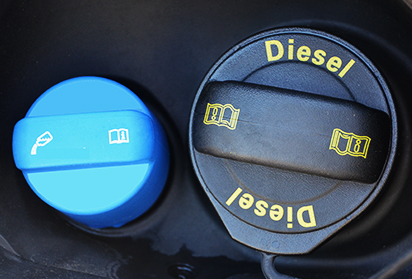You’ve probably seen AdBlue® stacked up at petrol stations, or you might have ordered a brand new car that has a separate filler cap next to its fuel cap – but, what is it used for and how can you keep it topped up? Let’s find out.
What is AdBlue®?
AdBlue® is a type of Diesel Exhaust Fluid (DEF) that helps diesel vehicles to meet the latest Euro 6 exhaust gas regulations. AdBlue® is a non-toxic, non-flammable, odourless and biodegradable water and urea-based solution. Ironically, it’s not blue.
How does it work?
Here’s where it gets technical – AdBlue® is injected through a catalyst into the vehicle’s exhaust as you drive, kick-starting a process called Selective Catalytic Reduction, or SCR. SCR reduces harmful pollutants by converting nitrogen oxides (NOx) into nitrogen, water and tiny amounts of carbon dioxide before being expelled from the exhaust.
How do I know if my vehicle uses AdBlue®?
AdBlue® is only used with diesel engines so, if you’re driving a petrol or electric vehicle, it won’t use AdBlue®.
If you’re driving a diesel car registered after September 2015, it’s best to check the vehicle handbook, as the use of AdBlue® differs by manufacturer.

Here’s some things to look out for:
- Does your vehicle have ‘Blue’ or ‘SCR’ in its model name?
- Are you driving a Euro 6 compliant diesel Audi, BMW, Citroën, Jaguar, Land Rover, Mercedes-Benz or Peugeot?
- Is there a separate tank filling cap to your fuel filling cap, in the boot or under the bonnet? Tip – it’s not always blue!
How long does it last?
Just like the use of fuel, the rate at which you use AdBlue® depends on your driving style, the vehicle’s engine and AdBlue® tank size. Generally, the more economically you drive, the longer it’ll last.
Volkswagen states that a passenger car can consume approximately 1.5 litres of AdBlue® every 620 miles. Based on a 12 litre tank size, the AdBlue® will be running low after approximately 5,000 miles. Other manufacturers have quoted between 3,000 and 12,000 miles – so it’s important to check with the manufacturer of your vehicle.
When your AdBlue® is running low, the warning light will come on. When this happens, top up as soon as you can.
What happens if it runs out?
If your AdBlue® warning light has only just come on, you shouldn’t notice any difference with your vehicle. It should drive as normal, allowing you to get to the petrol station for a top up.
If your light has been on for a while, you run the risk of completely running out of AdBlue®, which means your engine won’t start until it’s topped back up. Best to do it straight away, so there’s nothing to worry about.
Where can I buy it?
You can find AdBlue® at most petrol stations or manufacturer authorised repairers and some retailers including Halfords. Some petrol stations have AdBlue® dispensing pumps, whilst others offer portable containers.
The cost of AdBlue® varies, from around £1 per litre. Some manufacturers offer a fixed price, so it’s always useful to check.
This handy website helps you locate AdBlue® – www.findadblue.com
Don’t forget, as the driver of the vehicle, it’s your responsibility to keep your AdBlue® topped up. Many manufacturers advise against keeping AdBlue® top up bottles in your vehicle. It’s important to review your vehicle’s warranty, as some manufacturers may define certain AdBlue® standards.
How do I refill it?
Firstly, it’s important to read the handbook, which should provide instructions for how to top up and how large the AdBlue® tank is. AdBlue® should never be added into the fuel tank or mixed with fuel – it has its own separate tank.

The AdBlue® filler cap will generally be in one of three places:
- Next to your fuel cap
- Under the bonnet
- In the boot
Always refer to your handbook if you’re unsure. Many AdBlue® refill bottles come with a funnel, which helps if your filler cap is located under the bonnet or in the boot.
Before you begin, switch your engine off and ensure your vehicle is parked on a flat surface. You may want to use disposable gloves.
Once you’ve topped up the AdBlue®, wash your hands and use water to wipe away any spills or splashes from the bodywork of your vehicle.
What happens if I put AdBlue® in the diesel tank?
Do not switch the engine on. AdBlue® in your fuel tank can result in significant damage to the fuel tank, pump and injection system – it’ll need draining and refilling before you can start the ignition. If AdBlue® has made its way into the diesel tank, call us straight away.
What happens if I put diesel in the AdBlue® tank?
Do not switch the engine on. Diesel in your AdBlue® tank can result in significant damage to the SCR and AdBlue® systems. If you have accidentally topped up your AdBlue® tank with diesel, call us straight away.
